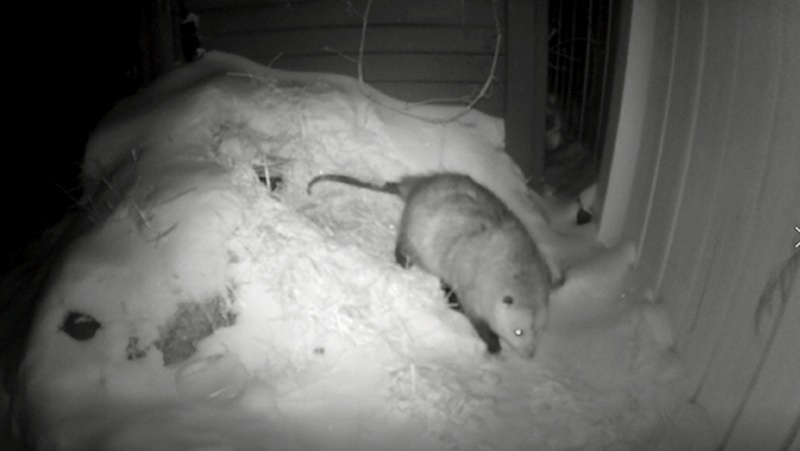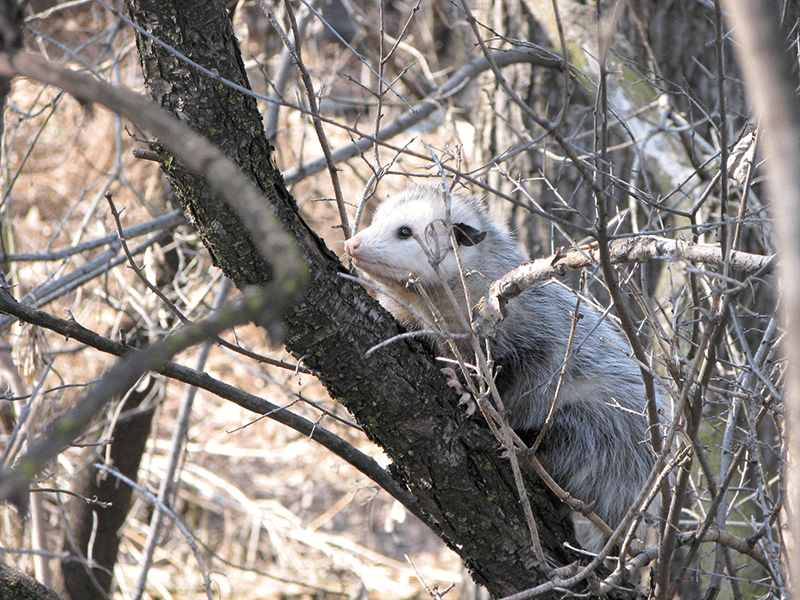Logan Park resident James Rosenau had captured opossums on his trail cam video over recent years, adults and young feeding in his yard at night, but he had never seen a behavior like the one the camera caught last January. The opossum sniffed at a rag, picked it up in its teeth, then pushed it underneath its body with its snout and front paws. Then, without looking back, it scooted forward a little, wrapped its tail around the rag and carried it away.
The prehensile tail is just one of the unusual traits that set opossums apart from other metro-area wildlife. Phrases along the lines of “fascinating creature,” “unique animal,” “misunderstood mammal” came up a lot as experts described the behaviors and biology of this relatively recent arrival to our city wildlife scene.
The rag-gathering behavior is not unusual, nor is the presence of the opossum, explained Scott Noland, area wildlife manager with the Minnesota Department of Natural Resources (DNR). It’s common for opossums to gather materials with their tails for their dens, and an increasing number of opossums have been making their dens in Minnesota, including in the metro area, he said.
The opossum species found here and elsewhere in the U.S. is called the Virginia opossum, which suggests it’s more of a southern creature, but it has slowly been making its way north. They have been in the southeast corner of Minnesota for about 100 years but in recent decades they have migrated northward, now found throughout the state as far north as Duluth and Grand Rapids, Noland said.
They aren’t suited for extreme cold, though, and their appearance makes that clear, Noland said. “They have hairless tails and ears, and then their nose – those are all pink.” He said they survive frigid temperatures by holing up for days in their dens, which they insulate with natural materials like grasses and sometimes human-made ones, like Rosenau’s rag.
For dens, opossums use existing cavities, like a hollow tree or an abandoned burrow, or they might live under outbuildings or in woodpiles. Rosenau has adapted a wooden yard waste box into a shelter, with the hope of helping animals like feral cats and an opossum he saw with “red burned ears” in the winter.
“I felt I had to help in some little way,” he said. Rosenau dug underneath the box and lined the structure with straw and 2-inch thick styrofoam. Although as far as he knows, the opossum with the frostbitten ears hasn’t used it, another one does. Rosenau has named that opossum “Maxie,” and during cold stretches he has seen Maxie’s tracks in the snow leading to and from the box and has captured the animal on his camera.
Noland emphasized that opossums aren’t a nuisance species. They don’t dig, aren’t affected by nor carry rabies and aren’t impacting other species in ways beyond what they naturally eat as part of their diet. They’re omnivores, eating fruit, grains, small bird eggs, insects, snakes and worms. Rosenau said that he’s seen opossums in his yard eating insects in his wildflower garden and rooting in a dirt pile in the alley. They also eat carrion, and that is often what leads the slow-moving opossums to become roadkill themselves, Noland said.
Roots and reproduction Opossum are marsupials – a type of mammal in which the young develop in a pouch. Although Australia most commonly comes to mind at the mention of pouched mammals, the Virginia opossum is one of about 100 species of marsupials that branched off and evolved into diverse niches in the Americas, explained Sharon Jansa, a professor in the Ecology, Evolution, and Behavior department at the University of Minnesota and curator of mammals at the Bell Museum of Natural History. One focus of Jansa’s research is South American opossums and their evolutionary relationships.
The Virginia opossum is the only marsupial that has made it this far north, though. “It’s one of the larger opossums. It’s probably better able to withstand the climatic variability of northern climates,” Jansa said, explaining that there is some evidence that the Virginia opossum has spread north by “island hopping,” using the urban heat islands of cities as a waypoint in the winter and migrating further north during the milder seasons.
Virginia opossums mate between January and May in Minnesota, and the young have a very short gestation period, Scott Noland explained. They are born between eight to 14 days after fertilization, at which point the bean-sized, hairless young will crawl into the pouch and attach to a teat, spending two months feeding and developing before they crawl out of the pouch and start traveling on the backs of the mother. On average, there are five or six in a litter, but the number can range from two to 13, Noland said.
Threats to opossums Opossums have a relatively short lifespan, between three to five years, according to Noland. In the metro area, dogs, coyotes and foxes are probably their most common predators, and they’re also hunted by hawks, owls and humans. Between 2,000 and 8,000 opossums are trapped or hunted each year in Minnesota, he said. The Wildlife Rehabilitation Center of Minnesota (WRC) admitted 440 opossums in 2021, and nearly 75 percent of them were young, some found in the pouches of dead females, said Tami Vogel, communications director for the center. Some were not well-developed enough to be saved, but some that were farther along could be tube-fed, raised and released.
With respect to the adults, one of the leading findings in admitted opossums is a high level of lead, Vogel said, which they have seen in other ground mammals such as squirrels and rabbits and birds such as robins. The lead compromises the nervous system and leads to behaviors that lead to injury. Opossums with high levels of lead become thin and lethargic and have trouble ambulating, Vogel said. “A healthy opossum is going to be moving around. It’s going to have a den that it’s going into, it’s going to be taking care of itself.” The opossum is more susceptible to dangers like frostbite, getting hit by a car, getting attacked by a dog. Although there isn’t a definitive answer yet to where the lead is coming from, it most likely is in the soil, having accumulated from environmental sources, Vogel said.
Vogel recommended keeping an eye on neighborhood opossums to look for signs of trouble. Opossums are nocturnal, but it’s not unusual for them to be seen during the day, so that’s not something to worry about. But if they have a ridge on their back, that’s their spine, and they’re too thin and should be live-trapped and brought to the WRC in Roseville. Blood in the snow in a pattern under a bird feeder could be from a opossum that has frostbite on either its paws or tail and also should be brought in.
Rosenau certainly keeps an eye out for the neighborhood opossums, as do his neighbors, who notice Maxie when it trips the motion detector lights in his yard. Right now he’s seeing only one set of tracks, but in the past he had deduced that one with frostbitten ears might have been living under a neighbor’s porch. In his yard, he provides concierge services, pushing away the snow from the opening to Maxie’s box. “They don’t hibernate; they’re out in this cold. I’m going to help a little,” he said.
Peculiar possum facts Opossums have 50 teeth, more than any other mammal in the U.S.
When an opossum “plays possum” – becomes limp and unreactive – it’s a physiological stress response, rather than a conscious ploy to feign death.
Venomous snakes are part of the Virginia opossum’s diet. They are immune to the venom of snakes found in their range.
Below: The opossum that uses a box in James Rosenau’s yard as a den in the winter. (Photo provided by James Rosenau) A young opossum treated and released by the Wildlife Rehabilitation Center of Minnesota. (Photo provided by the Center)













































